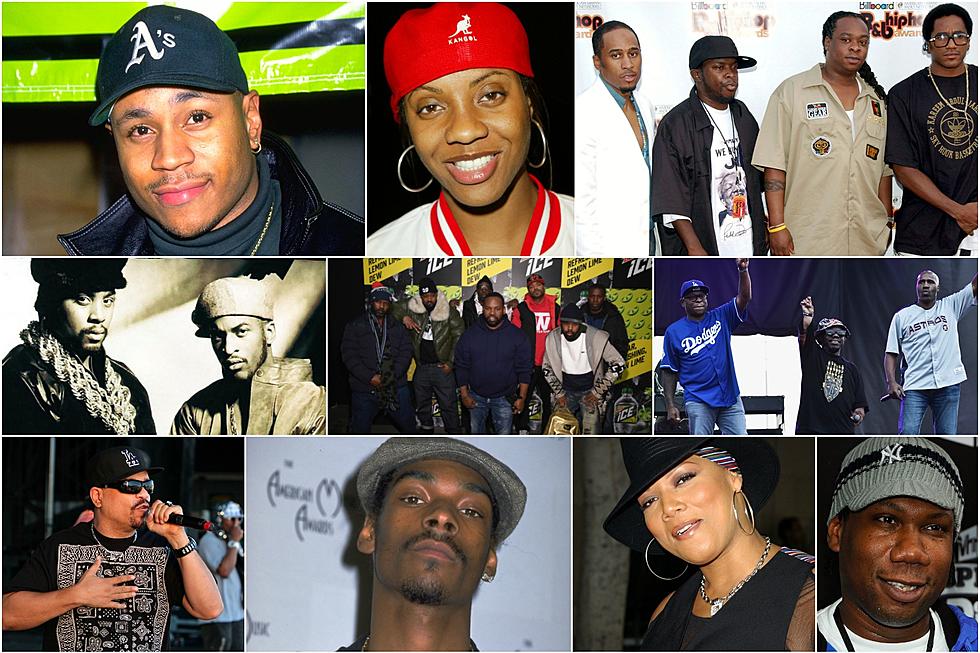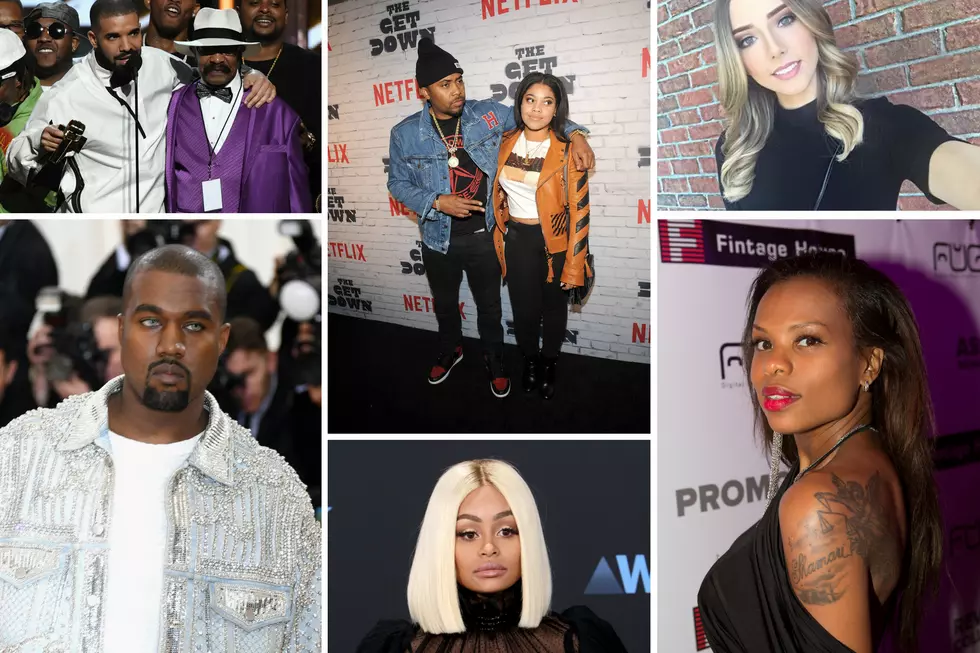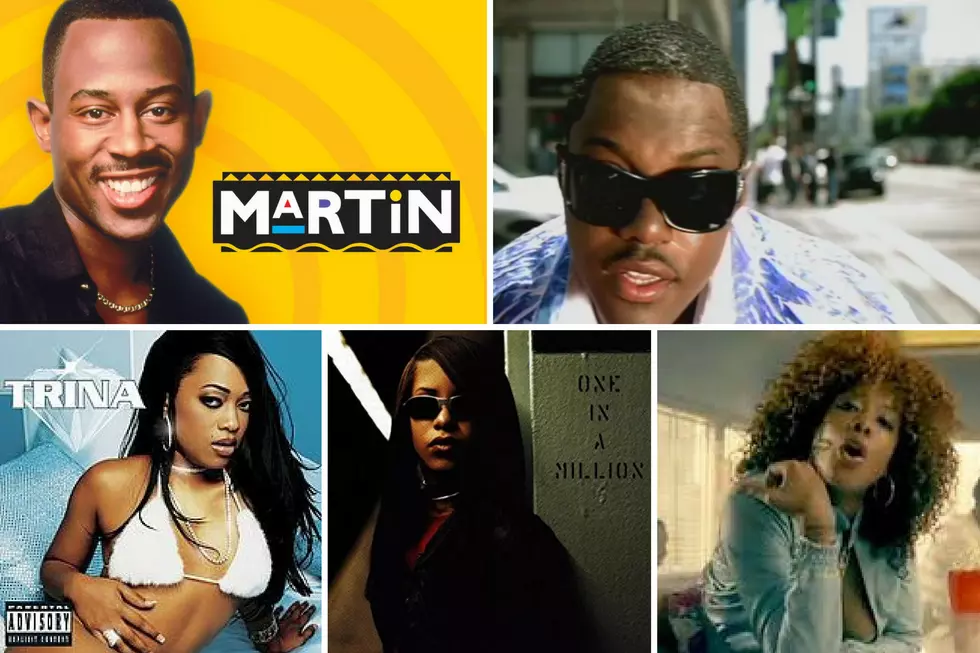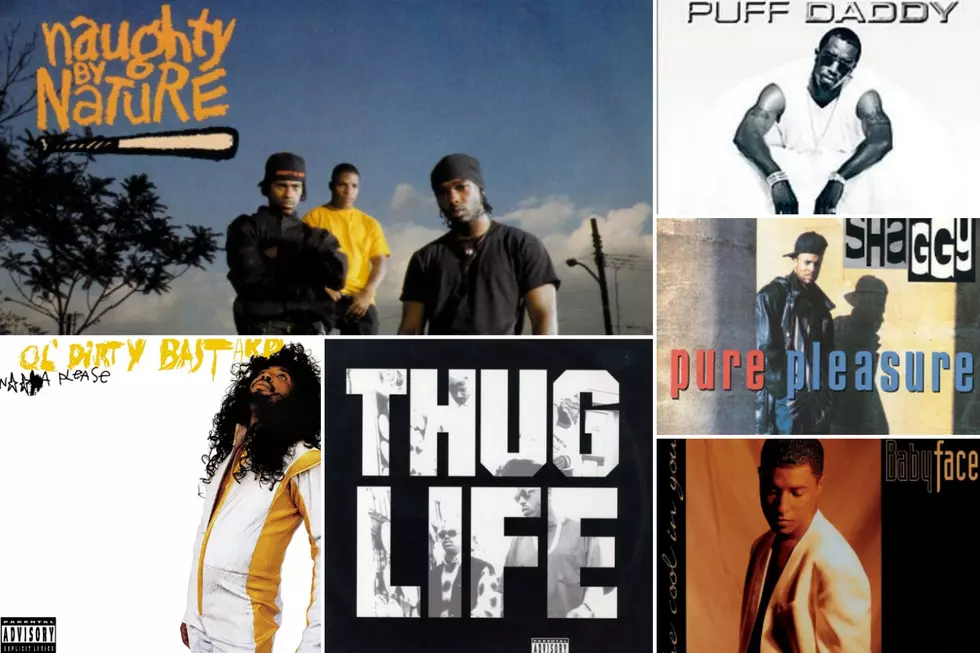
A Brief History of Rappers Singing
Future is hip-hop's intergalactic rap singer supreme. The ATLien's knack of switching up rapping for slipping into a strain of off-kilter, Auto-Tune-tweaked singing has seen him emerge as a pop culture phenomenon. The guest assists on his latest album, 'Honest,' pay testament to his status, as uber-stars Pharrell, Kanye West, Andre 3000 and Drake all pass through to salute his presumably blunt smoke-blackened lungs.
While Future's blurring of rapping and singing has taken him to superstardom, he's hip-hop's current omega symbol of the trilling brigade, not its alpha point. A conservative take on hip-hop's genesis might have steely MCs spitting braggadocio raps over savvily-sourced breakbeats, but even a cursory exploration of old school hip-hop tapes reveals an enthusiastic embrace of the idea of rappers flirting with singing from day one.
The Beginning: 1979-1990
Before hip-hop scored its inaugural official vinyl release in 1979 with the Sugarhill Gang's 'Rapper's Delight,' pioneering crews like the Cold Crush Brothers and the Furious Five took glee in rapping in a harmonized and highly-melodic manner during carefully choreographed live routines.
This trend continued with the first wave of formal rap releases: The Disco Four's upbeat 'Move to the Groove' (1980) features the Harlem clique segueing into a snatch of '70's rock outfit Wild Cherry's 'Play That Funky Music,' before closing the song out in terms that dabble in sing-song nursery rhyming; Disco Dave and the Force of the Five MC (later the Crash Crew) claimed a party-starter with 'High Power Rap,' a joyful exercise in rap harmony with bonus kazoo. (The song was later homaged by De La Soul and A Tribe Called Quest on 'Sh. Fe. MCs,' but more on Q-Tip's warbling later.)
From the same era, the Masterdon Committee's '82 electro workout 'Funkbox Party' is a mellifluous call-and-response jam. Archived footage from a performance at the Savoy Manor club in the Bronx a year later captures the group homaging Gladys Knight and Sly and the Family Stone songs.
That night, the Savoy also played host to a fresh-faced beat-boxer named Doug E. Fresh who would help usher in hip-hop's fabled golden era in tandem with a cocksure rapper calling himself Slick Rick. The impromptu duo's breakthrough, double whammy moment of 'The Show' and 'La-Di-Da-Di' showcased Rick's audacious take on singing, which he parsed in a mock British twang for added theatrics. The former MC Ricky D's take on Sukiyaki's 'Taste of Honey' was soon bested by a falsetto rendition of 'Walk On By' in the perky 'Mona Lisa.'
The Golden Era also spawned one of hip-hop's fiercest rap collectives, Marley Marl's The Juice Crew -- whose ranks included hip-hop's formative in-house crooner, TJ Swann. Most notably, Swanny's vocals pepped up MC Shan's 1987 crossover moment 'Left Me Lonely,' plus Biz Markie's chunk 'o funk 'Nobody Beats the Biz' and his ode to the Brooklyn retail scene 'Albee Square Mall.' Then it was the turn of the Biz himself to solidify his position as hip-hop's most beloved clown prince by trailblazing the art of rappers singing terribly with his karaoke-friendly heartbreak rap ballad 'Just A Friend.' (Another gem in Biz's vault is his team-up with the Beastie Boys for a cover of Elton John's 'Bennie and the Jets.')
While Biz was holding down the cartoonish side of hip-hop's golden era, he was flanked by rap's self-proclaimed teacher, KRS-One. As head of the Boogie Down Productions posse, KRS's pioneering 'Criminal Minded' movement was also infused with the MC breaking into standards by Billy Joel and the Beatles while engaging in the incendiary Bridge Wars with the Juice Crew. But the Blastmaster's finest contribution to the art of bizarre rap singing is channeling 'Ebony and Ivory' to spark his firearm-running commentary '100 Guns.' With hindsight, an album of Biz and KRS singing classic rock hits was an overlooked opportunity.
Born Into the '90s: 1990-1999
With the cusp of the '90s, a stylistic singing divide emerged in the rap world. On the West Coast, Snoop's lilting sing-song manner owed more of a debt to Slick Rick than gangsta rap icon Eazy-E's propensity to guffaw through profane versions of p-funk classics. The Doggfather also helped bring through the baritone brilliance of Nate Dogg -- a TJ Swann for the gangsta rap generation. In the Midwest, Eazy's new-found charges Bone Thugs 'n' Harmony were courting acclaim for a mellifluous, harmonized style of rap, with the Bone boys' vocals recorded in an intricately layered fashion. This was the slick and radio-ready facet of rap singing.
Over on the East Coast though, a motley coterie of '90's rappers were paying more of a debt to Biz's off-key crooning as they coined some of the most spectacularly atrocious singing ever released under the auspice of hip-hop. The ex-Brand Nubian lead figure Grand Puba can be counted as a pioneer of the movement, not least by going toe-to-toe with Mary J. Blige on 'What's the 411' and 'Check It Out.' Puba's 'Reel to Reel' album also ends with the peculiar psych-soul-styled 'Baby, What's Your Name?'
One-upping Puba in the god awful wailing stakes, Def Jam's forgotten trio Cru dropped the underrated 'Da Dirty 30' album in 1997, which included some top-notch terrible trilling from group member The Mighty Ha. His brusque brogue can be heard running through a smorgasbord of classic hits on 'Lisa Lipps,' including another Beatles connection with a few far-from-emotive lines from 'Yesterday.'
While the late, great and endearingly unhinged Ol' Dirty Bastard was also fond of channeling his inner karaoke singer, the finest moment of '90's New York vocal butchery comes from the Notorious BIG with 'Playa Hater.' It's a song that plots the tipping point of where something so horrendous becomes almost adorable. (Puff, of course, also insists on grabbing the mic before the song's been put out of its misery.)
The Millennium (Singing) Bug: 2000-2009
As the '90's ticked over to the noughties, rappers began to get serious about their singing again. Maybe inspired by hip-hop's increasing mainstream takeover, Q-Tip decided that merely emceeing wasn't enough for his creative whims so he put his vocal lessons to work with the at-the-time unreleased 'Kamal the Abstract' project. The outcome? Songs like 'Barely in Love,' which suggest the Abstract Poet harbored adult contemporary radio ambitions.
While Tip's solo sojourn was shelved by his label, Outkast's Andre 3000 was experiencing increasing returns on his melodic chops. The success of his hook duties on 'Ms. Jackson' prompted a full-on change to an all-singing and occasionally-rapping superstar come the time of Outkast's fractious 'Speakerboxxx/The Love Below' project. The retro-pop appeal of 'Hey Ya' became the mega-hit, but the hook to 'Roses' veers closer to 'Dre's rap roots.
Proving that thugs could trill too, foes 50 Cent and Ja Rule both embraced the fantasy of holding down their own hooks. While Ja eyed poppier climes, Fif flexed his menacing mushed brogue to brooding effect on 'Many Men.'
Buoyed by the success of his Dungeon Family cohort Andre 3000, the Goodie Mob's Cee-lo similarly shifted over from rapping to singing and scored a future wedding reception smash with the Dangermouse-crafted 'Crazy.' The oh-so-tortured soul of Kanye West also took a cue from Andre's lead and decided to sing his way through his '808s and Heartbreak' project -- although if a bunch of golden era rappers had deigned to interpolate the Beatles, 'Ye's karaoke repertoire seemed to cull from synth-based '80s sounds, as with the Tears For Fears-referencing 'Coldest Winter.'
Drake Season: 2008 - Now
Then came Drake, an upstart Canadian who was unabashedly boasting about his talent for both singing and rapping. Or rapping and singing. The two in Drizzy's mind were interchangeable means of expression, as proved with 2009's break-through 'Best I Ever Had,' which fused cocksure crooning with even more arrogant rap boasts. Drake's rise to stardom was a signifier of the times. Hip-hop's old school pioneers embellished their routines with harmonies for theatrical effect on the live circuit, while the MCs that followed broke out into song while keeping tongues firmly in cheek -- but there's nothing quirky about Drake meshing spitting with singing.
Future builds on Drake's multi-tasking brashness. He may be infatuated with visions of outer-space and celestial climes, but his music is also very funkily linked to hip-hop's roots.
Next step: A Future and Drizzy-commandeered update of 'Funk Box Party,' please.
More From TheBoombox






![20 Rappers Starring In Fun Commercials [VIDEO]](http://townsquare.media/site/625/files/2018/08/Rappers-and-Commericals.jpg?w=980&q=75)


